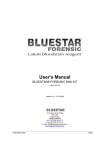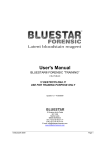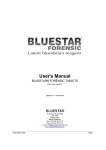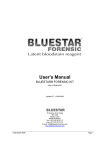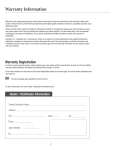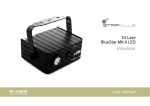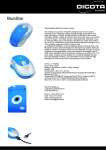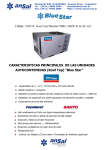Download BLUESTAR® FORENSIC MAGNUM user`s manual
Transcript
User's Manual BLUESTAR® FORENSIC MAGNUM # BL-FOR-MAG Update 9.7 – 03/30/2006 16 Avenue de la Costa B.P. 246 Monte Carlo 98005 MONACO Tel. (+377) 97 97 31 77 Fax (+377) 97 97 31 61 E-mail: [email protected] www.bluestar-forensic.com © Bluestar® 2006 Page 1 1 - MIXING INSTRUCTIONS Working solution ingredients - 125 ml (4 fl. oz) of BLUESTAR® FORENSIC MAGNUM chemiluminescent solution 3 tablets of oxidizer. Required items - spray bottle (mister) equipped with an adjustable spray nozzle Active life Best results are obtained when the product is used within 24 hours of mixing the oxidizer with the BLUESTAR® FORENSIC MAGNUM chemiluminescent solution. There is therefore no requirement to rush the investigation due to immediate product deterioration. Covered area A 125 ml (4 fl. oz) dose is generally sufficient to investigate a 25 m² (250 sq. ft.) area, to search a vehicle or an object (clothes, rug, knife, etc). Mixing procedure 1. Open the bottle of BLUESTAR® FORENSIC MAGNUM chemiluminescent solution and pour its content into a spray bottle (not included). 2. Add the 3 tablets. 3. Screw the head with its plunger on the spray bottle firmly. 4. Allow about 1 or 2 minutes for complete dissolution and mixing of the chemicals, stirring gently with a circular motion of your hand. Do NOT shake the container upside down. 2 - APPLICATION INSTRUCTIONS Lighting conditions The BLUESTAR® FORENSIC MAGNUM latent bloodstain reagent produces a very bright and long lasting blue chemiluminescence that does not require total obscurity to be visible. However, at high blood dilutions, the investigation will be much easier if the product is applied in total darkness. Furthermore, total darkness may allow the detection of tiny blood traces. Indoors: Close all the windows, block all outside light sources, and turn off all the lights. Outdoors: Wait for night time, and turn off all area lights in an urban environment. If necessary, screen off distant light sources, or even a very bright moon, and work facing away from parasite lights. Wait for at least 5 minutes so as to allow your eyes to adjust to darkness. Your pupils will dilate themselves and you will be able to better perceive the BLUESTAR® FORENSIC MAGNUM reaction. © Bluestar® 2006 Page 2 Vaporization In order to prevent biological contaminations of the revealed traces, wear personal protective equipment: safety goggles, gloves, dust respirator, protective clothing. Do not spray toward another person. The BLUESTAR® FORENSIC MAGNUM latent bloodstain reagent is designed to be vaporized from waist height in a fine mist. Adjust the spray nozzle to obtain the finest mist possible. Very little of it is actually needed. Overspraying does NOT result in improved blood detection, and in case the DNA is only available in very low quantities, over-spraying might dilute it too much for collecting exploitable samples, thus compromising its analysis. Check how the product reacts by spraying BLUESTAR® FORENSIC MAGNUM on a testing sample. This test will also help you become familiar with the reaction on blood. Spray lightly, horizontally ahead of you, at least 50 cm (2’) away from the target, in a side to side sweeping motion, NOT pointing toward the ground. Indoors: Be attentive not to saturate walls and vertical surfaces in order not to create drippings (as if you were spray painting). Outdoors: Pay attention to wind direction, if any. Do not spray into the wind, but use it to carry a light cloud of product over the area to investigate. Identifying "false" reactions When reacting to blood, the BLUESTAR® FORENSIC MAGNUM latent bloodstain reagent emits an intense lightblue chemiluminescence in the 420 to 440 nanometer range. However, "false" reactions may occur due to the presence of certain household detergents, chlorine, some paints and varnishes, copper, certain iron metabolizing plants such as lichens, thyme and some tree mosses, and certain soils containing iron. Such "false" reactions are easily identifiable by the trained technician because their color, brightness, and duration differ from those of the typical reaction on blood. Typically, "false" reactions are markedly dimmer and whiter. "False" reactions due to chlorinated detergents are often interesting, because they may reveal attempts to wash or clean bloodstains, and to conceal a homicide. 3 - PHOTOGRAPHY Photography of latent blood prints developed with chemiluminescence is not fundamentally different from regular daylight photography. The same four basic elements of photography (subject lighting, film sensitivity, aperture opening, and shutter speed) interact in exactly the same way. Photography of BLUESTAR® FORENSIC MAGNUM detected blood prints is easy and produces excellent results. Equipment The chemiluminescence produced by the reaction of the BLUESTAR® FORENSIC MAGNUM latent bloodstain reagent to blood is bright enough that no special equipment is needed. However, relatively long exposures may be needed for maximum picture quality and a tripod and flexible cable release are highly recommended in order to maintain the camera motionless during the time of the exposure. A 24 mm objective is recommended. © Bluestar® 2006 Page 3 Film No special film is required, but it is advisable to use low-light fast films in order to obtain acceptably short exposure times. A film speed of ASA 400 is generally suitable. Lighting conditions Total darkness is not required. Natural low intensity diffused light is preferred. Artificial light (tungsten or fluorescent) produces yellowish or greenish pictures. A flash should be avoided. Instructions to obtain good pictures 1. Set the camera on a tripod, perpendicular to the area to be photographed. 2. Disable the automatic flash and the autofocus mode if the camera has one. 3. Use a large lens aperture, typically a f/2.8 "f/stop" value. 4. Set the exposure time to "B". 5. Focus the lens manually over a spot of light provided by a flashlight over the blood area. 6. Turn off all the lights, but total darkness is unnecessary. Pictures shot in dimmed light will allow you to view not only the trace, but other details of the scene as well. 7. Re-spray the blood print to reactivate a bright chemiluminescence reaction. 8. Shoot several pictures using different shutter speeds, typically 30 seconds. 4 - COLLECTING BIOLOGICAL PRINTS Samples of the revealed biological prints for subsequent DNA analysis are collected using the same methods as for any kind of biological prints. 5 - STORAGE, CLEANING & DISPOSAL Storage The BLUESTAR® FORENSIC MAGNUM latent bloodstain reagent has a 3 year shelf life AFTER MANUFACTURING (expiration date imprinted on back of package) prior to mixing. If you wish to use the product after this date, we recommend that you perform a test to check the product performances. Note: The product is warranted for 2 years after the DATE OF PURCHASE. DO NOT attempt to store the product AFTER MIXING it with the oxidizing tablets. The mixed product is an active chemical compound that oxidizes. Inert gases are constantly released and will in time accumulate under pressure in a sealed container, causing swelling and leaking. Cleaning Since the BLUESTAR® FORENSIC MAGNUM latent bloodstain reagent is designed to be used on presumed blood on crime scenes, all precautions and regulations related to the biohazards of blood apply when cleaning. © Bluestar® 2006 Page 4 Disposal Dispose of unused BLUESTAR® FORENSIC MAGNUM solution in a sink under running water. Dispose of cleaning residues according to local, state, and federal regulations applying to the biohazards of blood. 6 - MATERIAL SAFETY DATA SHEETS Material safety data sheets (MSDS) for the BLUESTAR® FORENSIC MAGNUM bottle, tablets and working solution are available in PDF format on our web site: www.bluestar-forensic.com/gb/download.php. © Bluestar® 2006 Page 5





